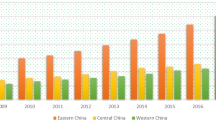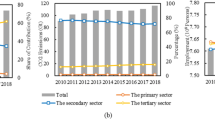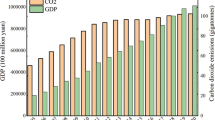Abstract
Human capital (HC) plays a crucial role in economic growth, and also has a considerable effect on environmental performance, including carbon emissions (CEs). Existing studies have drawn inconsistent conclusions on whether and how HC affects CEs, and most of them conduct case studies of a certain country or several countries with similar economic backgrounds. In order to accurately determine the effect and the influence mechanism of HC on CEs, this research conducted an empirical study by applying econometric method and the panel data of 125 countries over the period 2000–2019. The empirical results indicate that there is an inverted U-shaped nexus between HC and CEs of full sample countries, revealing that HC will increase CEs before turning point and decrease CEs after turning point. From a heterogeneity perspective, this inverted U-shaped nexus only exists in high and upper-middle income countries, while is not supported in low and lower-middle income countries. This study further disclosed that HC can affect CEs by the mediating effects of labor productivity, energy intensity, and industrial structure from a macro perspective. Specifically, HC will increase CEs by promoting labor productivity, while decrease CEs by reducing energy intensity and the proportion of secondary industry. These results can provide important references for governments of different countries to make tailored carbon reduction policies according to the mitigation effect of HC on CEs.




Similar content being viewed by others
Data availability
Data and materials are available from the authors upon request.
References
Acheampong AO, Amponsah M, Boateng E (2020) Does financial development mitigate carbon emissions? Evidence from heterogeneous financial economies. Energy Econ 88:104768
Ahmad A, Zhao Y, Shahbaz M, Bano S, Zhang Z, Wang S, Liu Y (2016) Carbon emissions, energy consumption and economic growth: an aggregate and disaggregate analysis of the Indian economy. Energy Policy 96:131–143
Ahmed Z, Nathaniel SP, Shahbaz M (2021) The criticality of information and communication technology and human capital in environmental sustainability: evidence from Latin American and Caribbean countries. J Clean Prod 286:125529
Akram V, Jangam BP, Rath BN (2019) Does human capital matter for reduction in energy consumption in India? Int J Energy Sector Manag 13(2):359–376
Balaguer J, Cantavella M (2018) The role of education in the environmental Kuznets curve. Evidence from Australian data. Energy Econ 70:289–296
Bano S, Zhao Y, Ahmad A, Wang S, Liu Y (2018) Identifying the impacts of human capital on carbon emissions in Pakistan. J Clean Prod 183:1082–1092
Baumann F (2021) The next frontier—human development and the anthropocene: UNDP human development report 2020. Environ Sci Policy Sustain Dev 63:34–40
Becker GS (1962) Investment in human capital: a theoretical analysis. J Polit Econ 70:9–49
Becker GS (2009) Human capital: a theoretical and empirical analysis, with special reference to education. University of Chicago press
Benjamin NI, Lin B (2020) Quantile analysis of carbon emissions in China metallurgy industry. J Clean Prod 243:118534
Blackman A, Kildegaard A (2010) Clean technological change in developing-country industrial clusters: Mexican leather tanning. Environ Econ Policy Stud 12:115–132
Çakar ND, Gedikli A, Erdoğan S, Yıldırım DÇ (2021) Exploring the nexus between human capital and environmental degradation: the case of EU countries. J Environ Manag 295:113057
Carneiro PM, Heckman JJ (2003) Human capital policy. NBER Working Paper, (w9495)
Chengliang L, Qingbin G, Rui Z (2017) The dynamic effects of endogenous technological advancement on carbon emissions in China. China Int J 15:192–207
Dietz T, Rosa EA (1997) Effects of population and affluence on CO2 emissions. Proc Natl Acad Sci 94:175–179
Du X, Shen L, Ren Y, Meng C (2022) A dimensional perspective-based analysis on the practice of low carbon city in China. Environ Impact Assess Rev 95:106768
Du X, Shen L, Wong SW, Meng C, Yang Z (2021) Night-time light data based decoupling relationship analysis between economic growth and carbon emission in 289 Chinese cities. Sust Cities Soc 73:103119
Du Z, Lin B (2018) Analysis of carbon emissions reduction of China's metallurgical industry. J Clean Prod 176:1177–1184
Dumitrescu E-I, Hurlin C (2012) Testing for Granger non-causality in heterogeneous panels. Econ Model 29:1450–1460
Engelman R, Macharia J, Zahedi K, Jallow B, Boncour P (2009) Facing a changing world: women, population and climate. The state of world population.
ESRC, 2011. When it comes to the environments, the education affects our actions. https://www.sciencedaily.com/releases/2011/03/110321093843.htm (accessed 12 December 2021).
Feenstra RC, Inklaar R, Timmer MP (2015) The next generation of the Penn World Table. Am Econ Rev 105:3150–3182
Friedlingstein P, O'sullivan M, Jones MW, Andrew RM, Hauck J, Olsen A, Peters GP, Peters W, Pongratz J, Sitch S (2020) Global carbon budget 2020. Earth Syst Sci Data 12:3269–3340
Fullerton D, Ta CL (2020) Costs of energy efficiency mandates can reverse the sign of rebound. J Public Econ 188:104225
Ganda F (2021) The environmental impacts of human capital in the BRICS Economies. J Knowl Econ:1–24
Gennaioli N, La Porta R, Lopez-de-Silanes F, Shleifer A (2013) Human capital and regional development. Q J Econ 128:105–164
Grossman GM, Krueger AB (1995) Economic growth and the environment. Q J Econ 110:353–377
Hao L-N, Umar M, Khan Z, Ali W (2021) Green growth and low carbon emission in G7 countries: how critical the network of environmental taxes, renewable energy and human capital is? Sci Total Environ 752:141853
Hassan T, Song H, Khan Y, Kirikkaleli D (2022) Energy efficiency a source of low carbon energy sources? Evidence from 16 high-income OECD economies. Energy 243:123063
Hsieh C-T, Klenow PJ (2009) Misallocation and manufacturing TFP in China and India. Q J Econ 124:1403–1448
Huang C, Zhang X, Liu K (2021) Effects of human capital structural evolution on carbon emissions intensity in China: a dual perspective of spatial heterogeneity and nonlinear linkages. Renew Sustain Energy Rev 135:110258
IPCC (2021) Climate Change 2021: The physical science basis. Contribution of Working Group I to the Sixth Assessment Report of the Intergovernmental Panel on Climate Change. Cambridge University Press In Press
Jahanger A (2021) Impact of globalization on CO2 emissions based on EKC hypothesis in developing world: the moderating role of human capital. Environ Sci Pollut Res:1–21
Jiang L, Hardee K (2011) How do recent population trends matter to climate change? Popul Res Policy Rev 30:287–312
Khan Y, Hassan T, Tufail M, Marie M, Imran M, Xiuqin Z (2022) The nexus between CO2 emissions, human capital, technology transfer, and renewable energy: evidence from Belt and Road countries. Environ Sci Pollut Res 29:59816–59834
Khan Z, Ali S, Dong K, Li RYM (2021) How does fiscal decentralization affect CO2 emissions? The roles of institutions and human capital. Energy Econ 94:105060
Komal R, Abbas F (2015) Linking financial development, economic growth and energy consumption in Pakistan. Renew Sustain Energy Rev 44:211–220
Lan J, Munro A (2013) Environmental compliance and human capital: evidence from Chinese industrial firms. Resour Energy Econ 35:534–557
Langnel Z, Amegavi GB, Donkor P, Mensah JK (2021) Income inequality, human capital, natural resource abundance, and ecological footprint in ECOWAS member countries. Resour Policy 74:102255
Lin B, Ma R (2022) Green technology innovations, urban innovation environment and CO2 emission reduction in China: fresh evidence from a partially linear functional-coefficient panel model. Technol Forecast Soc Chang 176:121434
Lin B, Tan R (2017) Sustainable development of China’s energy intensive industries: from the aspect of carbon dioxide emissions reduction. Renew Sustain Energy Rev 77:386–394
Lin X, Zhao Y, Ahmad M, Ahmed Z, Rjoub H, Adebayo TS (2021) Linking innovative human capital, economic growth, and CO2 emissions: an empirical study based on Chinese provincial panel data. Int J Environ Res Public Health 18:8503
Liu X, Zhang X (2021) Industrial agglomeration, technological innovation and carbon productivity: evidence from China. Resour, Conserv Recycl 166:105330
Liu Y, Sohail MT, Khan A, Majeed MT (2021) Environmental benefit of clean energy consumption: can BRICS economies achieve environmental sustainability through human capital? Environ Sci Pollut Res:1–11
Lucas RE Jr (1988) On the mechanics of economic development. J Monet Econ 22:3–42
Manderson E, Kneller R (2012) Environmental regulations, outward FDI and heterogeneous firms: are countries used as pollution havens? Environ Resour Econ 51:317–352
Mi Z, Sun X (2021) Provinces with transitions in industrial structure and energy mix performed best in climate change mitigation in China. Commun Earth Environ 2:1–12
Muhammad S, Long X, Salman M, Dauda L (2020) Effect of urbanization and international trade on CO2 emissions across 65 belt and road initiative countries. Energy 196:117102
Pablo-Romero MP, Sánchez-Braza A (2015) Productive energy use and economic growth: energy, physical and human capital relationships. Energy Econ 49:420–429
Pasban M, Nojedeh SH (2016) A review of the role of human capital in the organization. Procedia Soc Behav Sci 230:249–253
Pata UK, Caglar AE (2021) Investigating the EKC hypothesis with renewable energy consumption, human capital, globalization and trade openness for China: evidence from augmented ARDL approach with a structural break. Energy 216:119220
Pedroni P (2004) Panel cointegration: asymptotic and finite sample properties of pooled time series tests with an application to the PPP hypothesis. Economet Theory 20:597–625
Pesaran MH (2004) General diagnostic tests for cross section dependence in panels (IZA Discussion Paper No. 1240). Institute for the Study of Labor (IZA)
Pesaran MH (2007) A simple panel unit root test in the presence of cross-section dependence. J Appl Economet 22:265–312
Piesse J, Thirtle C (1997) Sector-level efficiency and productivity in Hungarian primary, secondary, and tertiary industries, 1985–1991. East Eur Econ 35:5–39
Romer PM (1990) Endogenous technological change. J Polit Econ 98:S71–S102
Sapkota P, Bastola U (2017) Foreign direct investment, income, and environmental pollution in developing countries: panel data analysis of Latin America. Energy Econ 64:206–212
Sarkodie SA, Adams S, Owusu PA, Leirvik T, Ozturk I (2020) Mitigating degradation and emissions in China: the role of environmental sustainability, human capital and renewable energy. Sci Total Environ 719:137530
Schultz TW (1960) Capital formation by education. J Polit Econ 68:571–583
Sehrawat M (2021) Modelling the nexus between human capital, income inequality, and energy demand in India: new evidences from asymmetric and non-linear analysis. Environ Sci Pollut Res 28:3632–3643
Sheraz M, Deyi X, Ahmed J, Ullah S, Ullah A (2021) Moderating the effect of globalization on financial development, energy consumption, human capital, and carbon emissions: evidence from G20 countries. Environ Sci Pollut Res:1–19
Sohag K, Begum RA, Abdullah SMS, Jaafar M (2015) Dynamics of energy use, technological innovation, economic growth and trade openness in Malaysia. Energy 90:1497–1507
Ulucak R (2020) How do environmental technologies affect green growth? Evidence from BRICS economies. Sci Total Environ 712:136504
UNDRR, 2020. The human cost of disasters: an overview of the last 20 years (2000-2019). https://www.preventionweb.net/publication/human-cost-disasters-overview-last-20-years-2000-2019 (accessed 11 March 2022).
Wang F, Shackman J, Liu X (2017) Carbon emission flow in the power industry and provincial CO2 emissions: evidence from cross-provincial secondary energy trading in China. J Clean Prod 159:397–409
Wang J, Xu Y (2021) Internet usage, human capital and CO2 emissions: a global perspective. Sustainability 13:8268
Wang JF, Wu YQ, Zhao Y, He ST, Dong ZF, Bo WG (2019) The population structural transition effect on rising per capita CO2 emissions: evidence from China. Clim Policy 19:1250–1269
Wang Q, Li L (2021) The effects of population aging, life expectancy, unemployment rate, population density, per capita GDP, urbanization on per capita carbon emissions. Sustain Prod Consump 28:760–774
World Bank dataset (2021) World development indicators. https://data.worldbank.org/indicator. Accessed 15 May 2022
Yao Y, Ivanovski K, Inekwe J, Smyth R (2020) Human capital and CO2 emissions in the long run. Energy Econ 91:104907
York R, Rosa EA, Dietz T (2002) Bridging environmental science with environmental policy: plasticity of population, affluence, and technology. Soc Sci Q 83:18–34
Zhang J, Lyu Y, Li Y, Geng Y (2022) Digital economy: an innovation driving factor for low-carbon development. Environ Impact Assess Rev 96:106821
Zhang L, Godil DI, Bibi M, Khan MK, Sarwat S, Anser MK (2021) Caring for the environment: how human capital, natural resources, and economic growth interact with environmental degradation in Pakistan? A dynamic ARDL approach. Sci Total Environ 774:145553
Zhao S (2008) Application of human capital theory in China in the context of the knowledge economy. Int J Hum Resour Manag 19:802–817
Zhu B, Zhang M, Huang L, Wang P, Su B, Wei Y-M (2020) Exploring the effect of carbon trading mechanism on China’s green development efficiency: a novel integrated approach. Energy Econ 85:104601
Funding
This work is supported by the Fundamental Research Funds for the Central Universities of China (Project No. “2021CDJSKZD03” and “2020CDJSK03PT18”) and the National Natural Science Foundation of China (Project No. “72101237” and No. “72101238”).
Author information
Authors and Affiliations
Contributions
All authors contributed to the study conception and design. Material preparation, data collection, and analysis were performed by Jun Xiao and Xiaoyun Du. The first draft of the manuscript was written by Jun Xiao. Supervision, funding acquisition, and review were performed by Liyin Shen. And all authors commented on previous versions of the manuscript. All authors read and approved the final manuscript.
Corresponding author
Ethics declarations
Ethics approval
Not applicable.
Consent to participate
Not applicable.
Consent for publication
Not applicable.
Competing interests
The authors declare no competing interests.
Additional information
Responsible Editor: V.V.S.S. Sarma
Publisher’s note
Springer Nature remains neutral with regard to jurisdictional claims in published maps and institutional affiliations.
Appendix
Appendix
Rights and permissions
Springer Nature or its licensor (e.g. a society or other partner) holds exclusive rights to this article under a publishing agreement with the author(s) or other rightsholder(s); author self-archiving of the accepted manuscript version of this article is solely governed by the terms of such publishing agreement and applicable law.
About this article
Cite this article
Xiao, J., Shen, L. & Du, X. Exploring the effect of human capital on carbon emissions: evidences from 125 countries. Environ Sci Pollut Res 30, 85429–85445 (2023). https://doi.org/10.1007/s11356-023-28381-4
Received:
Accepted:
Published:
Issue Date:
DOI: https://doi.org/10.1007/s11356-023-28381-4




